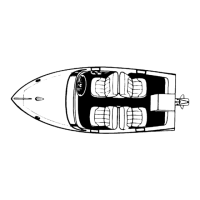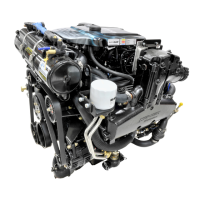STARTING SYSTEM - 4A-1390-823225--1 1096
Maintenance
!
WARNING
DO NOT use jumper cables and a booster battery
to start engine. DO NOT recharge a weak battery
in the boat. Remove battery and recharge in a
well ventilated area away from fuel vapors,
sparks or flames.
!
WARNING
Batteries contain acid which can cause severe
burns. Avoid contact with skin, eyes and cloth-
ing. Batteries also produce hydrogen and oxy-
gen gases when being charged. This explosive
gas escapes fill/vent caps and may form an ex-
plosive atmosphere around the battery for sever-
al hours after it has been charged; sparks or
flames can ignite the gas and cause an explosion
which may shatter the battery and could cause
blindness or other serious injury.
Safety glasses and rubber gloves are recom-
mended when handling batteries or filling elec-
trolyte. Hydrogen gases that escape from the
battery during charging are explosive. When
charging batteries, be sure battery compartment,
or area where batteries are located, is well
vented. Battery electrolyte is a corrosive acid
and should be handled with care. If electrolyte is
spilled or splashed on any part of the body, im-
mediately flush the exposed area with liberal
amounts of water and obtain medical aid as soon
as possible.
!
CAUTION
To prevent damage to the electrical system be
sure to adhere to the following:
• When installing battery, be sure to connect
the positive (+) battery cable to positive (+)
battery terminal first and then the negative (–)
battery cable to negative (–) battery terminal.
• Never disconnect the battery cables while the
engine is running.
• If a charger or booster is to be used, be sure to
connect it in parallel with existing battery
(positive to positive and negative to nega-
tive).
• When applying a booster charge to battery,
disconnect both cables from battery (to pre-
vent damage to voltage regulator).
• Check battery condition periodically.
• Make sure that battery leads are kept clean
and tight.
Testing
!
CAUTION
Test battery in well ventilated area as gases given
off by battery are hazardous.
Place battery under heavy load (as during engine
cranking or with a variable resistor tester) and test
cell voltage while under load.
Certain conditions must be met before testing:
• Battery must be 60 to 100°F (16 to 38°C).
• Electrolyte level must be correct in all cells.
• Battery must be at least half charged.
• No obvious defects.
1. Check voltage per manufacturer’s specifications.
2. If readings are low, recharge and retest.
3. If readings remain low, battery should be re-
placed.
Storage
1. Remove battery and clean exterior.
2. Check fluid level and fill if low.
3. Cover terminals and bolts with light coat of
grease.
4. Set battery on wood or in carton; store in cool, dry
place.
5. Check every 20 days for fluid level and slow
charge.
IMPORTANT: A discharged battery can be dam-
aged by freezing.

